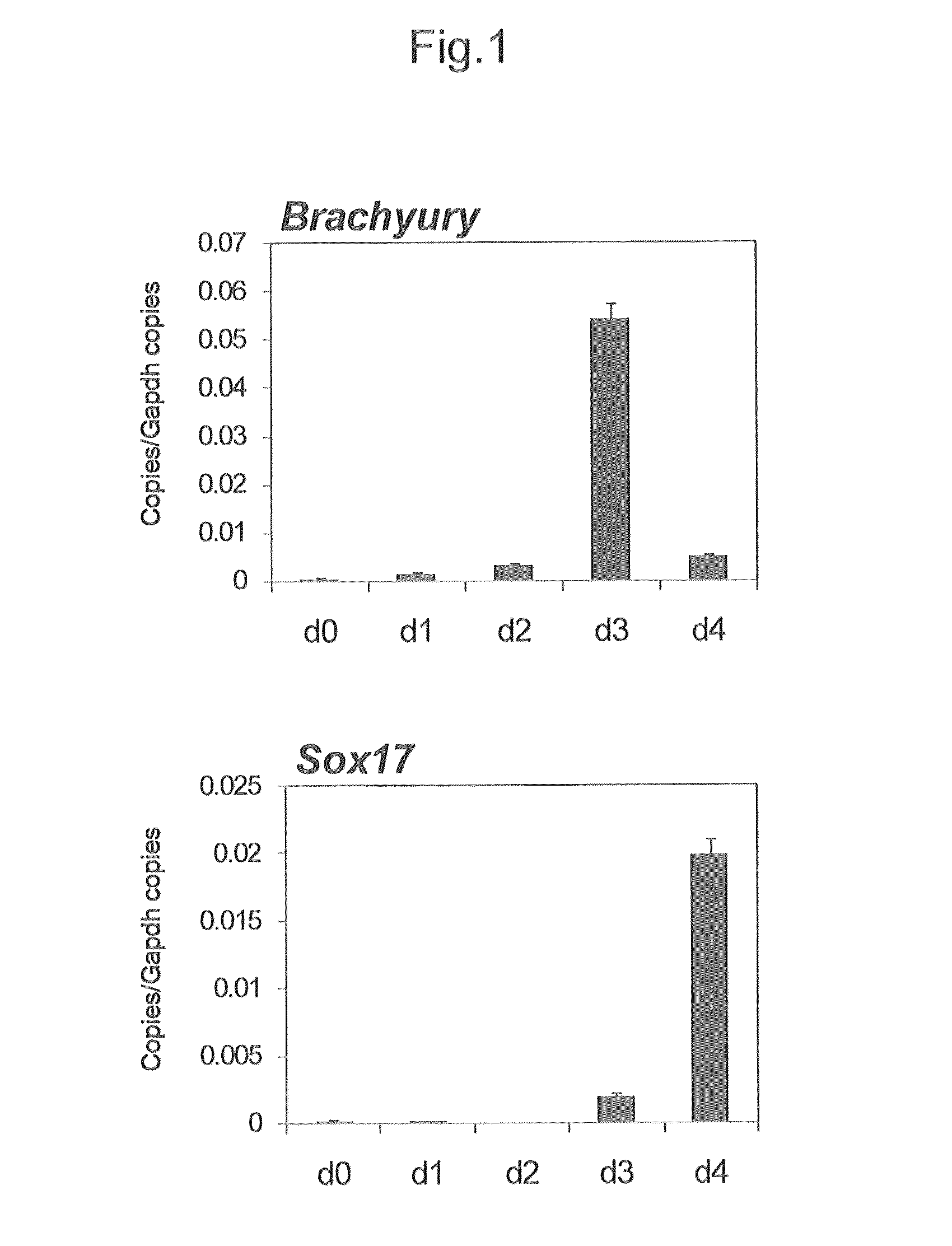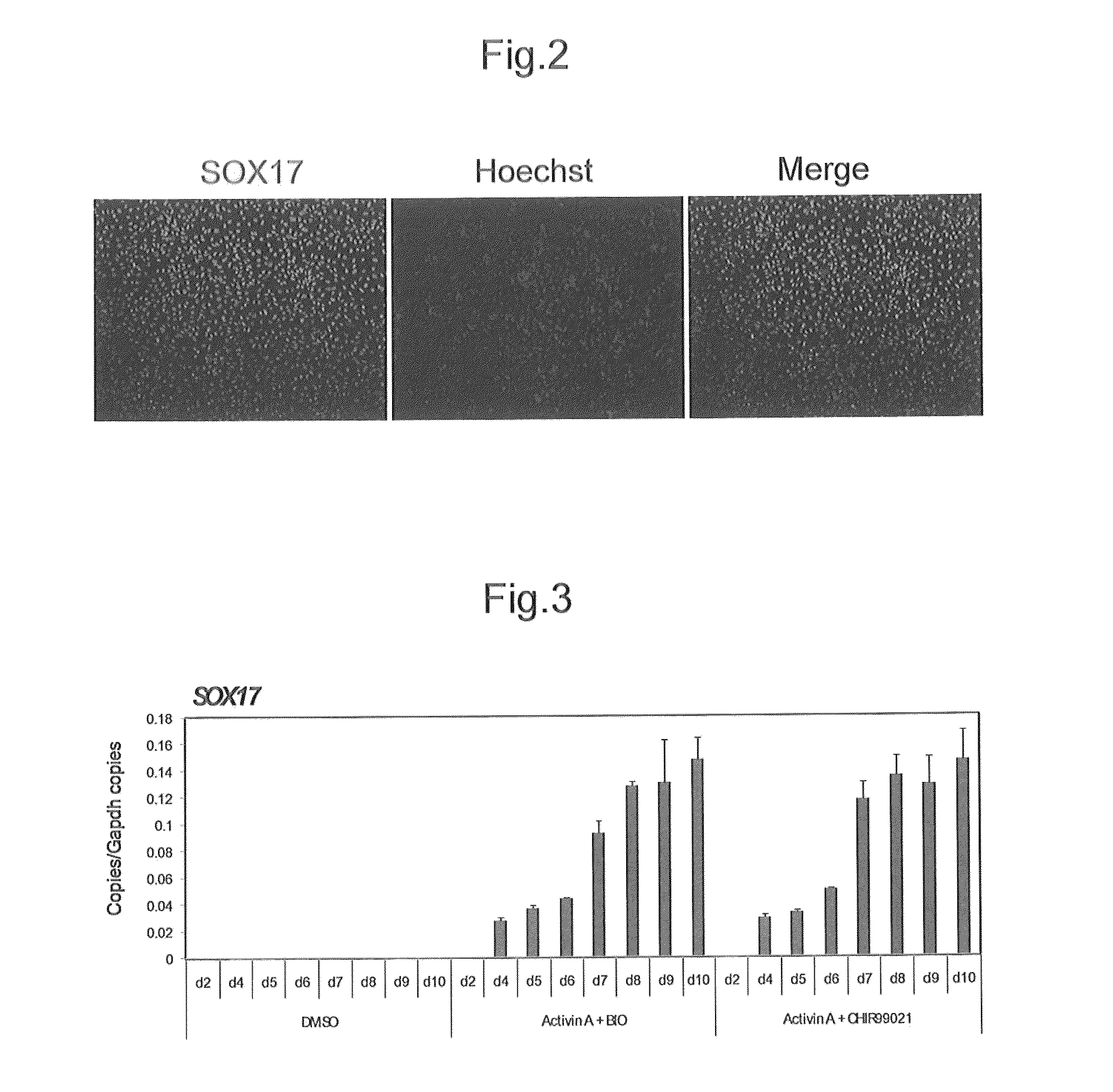Method of producing pancreatic hormone-producing cells
a hormone-producing cell and pancreatic technology, applied in the direction of drug compositions, peptides, metabolism disorders, etc., can solve the problems of insufficient transplantation technique, insufficient pancreas and pancreatic islets, and difficult cur
- Summary
- Abstract
- Description
- Claims
- Application Information
AI Technical Summary
Benefits of technology
Problems solved by technology
Method used
Image
Examples
example 1 (
2)
Endoderm Induction by GSK3 Inhibitor (BIO) Other than CHIR99021 in Step (2) was Studied
[0229]One day after seeding of human iPS cells, the medium was exchanged with DMEM / F12 medium containing CHIR99021 (3 μM) and 2% B-27 supplement (GIBCO), and cultured for 2 days.
[0230]Then, one was exchanged with DMEM / F12 medium containing CHIR99021 (3 μM) as GSK3 inhibitor and activin A (100 ng / ml) and 2% B-27 supplement (GIBCO), and culture was continued (indicated as “Activin A+CHIR99021” in FIG. 3).
[0231]The other was exchanged with DMEM / F12 medium containing BIO (0.5 μM) as GSK3 inhibitor and activin A (100 ng / ml), and 2% B-27 supplement (GIBCO), and culture was continued (indicated as “Activin A+BIO” in FIG. 3).
[0232]The level of the gene expression of SOX17 when human iPS cells were cultured was measured over time. The results of expression analysis are shown in FIG. 3. Whether using CHIR99021 or BIO, the expression level of SOX17 remarkably increased from day 4 of culture, and a similar ...
example 2
Induction of Differentiation of Endodermal Cells into Pancreatic Hormone-Producing Cells
Steps (4)-(6)
[0233]A cell mass was formed from cells differentiated into endodermal cells, after which further induced to differentiate into progenitor cells of pancreatic hormone-producing cells, then into pancreatic hormone-producing cells.
[0234]Using endodermal cells induced to differentiate in a 100 mm dish were dissociated until they form singulated cells by using Accutase (Invitrogen) (trade name). Then, endodermal cells dispersed in a medium were seeded at a density of 2×104 cells per well in a 96-well spheroid plate (SUMITOMO BAKELITE), and cultured at 37° C., 5% CO2 for 1 day to form a cell mass. As a medium for dispersion and seeding, Improved MEM Zinc Option medium containing 1% B-27 supplement was used. One day from endodermal cell seeding, the medium was exchanged with Improved MEM Zinc Option medium containing 1% B-27 supplement and added with dorsomorphin (1 μM), retinoic acid (2 μ...
example 3
Induction of Differentiation of Human iPS Cell into Pancreatic Hormone-Producing Cell
Steps (1)-(6); Induction of Differentiation into Endodermal Cells Using BD Matrigel or Fibronectin, and Induction of Differentiation into Pancreatic Hormone-Producing Cells
[0238]Induction of differentiation of human iPS cells into endodermal cells was performed by the following method.
[0239]First, human iPS cells maintained in the state of a cell mass were dissociated until they formed singulated cells in the same manner as in Example 1.
[0240]Then, human iPS cells dispersed in a medium were seeded at a density of 60×104 cells per one 100 mm dish coated with fibronectin (Invitrogen), and cultured at 37° C., 5% CO2 for 1 day. The 100 mm dish used was one coated with fibronectin diluted 40-fold with serum-free DMEM / F12 medium (Invitrogen), at room temperature for 3 hr or longer. (indicated as “fibronectin” in FIG. 7)
[0241]Human iPS cells dispersed in a medium were seeded at a density of 15×104 cells pe...
PUM
| Property | Measurement | Unit |
|---|---|---|
| temperature | aaaaa | aaaaa |
| temperature | aaaaa | aaaaa |
| concentration | aaaaa | aaaaa |
Abstract
Description
Claims
Application Information
 Login to View More
Login to View More - R&D
- Intellectual Property
- Life Sciences
- Materials
- Tech Scout
- Unparalleled Data Quality
- Higher Quality Content
- 60% Fewer Hallucinations
Browse by: Latest US Patents, China's latest patents, Technical Efficacy Thesaurus, Application Domain, Technology Topic, Popular Technical Reports.
© 2025 PatSnap. All rights reserved.Legal|Privacy policy|Modern Slavery Act Transparency Statement|Sitemap|About US| Contact US: help@patsnap.com



